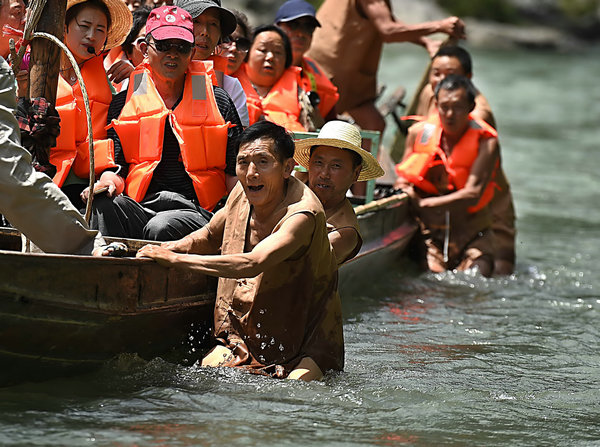The gorgeous gorges on Yangtze River
 |
|
Tourists experience a trip on a boat dragged by boatmen along the Shennong stream in the Three Gorges area. [Photo by Liu Junfeng, Xiong Bin and Zhu Xiyong/China Daily] |
The plan coordinates the activities of the region's cities and provinces, especially Chongqing and Hubei, to improve infrastructure, upgrade travel facilities and develop new scenic spots.
Chongqing Normal University tourism expert Hu Zhiyi says that, compared with the "old" Three Gorges, the current area offers diversified landscapes, such as lakes.
"More importantly, the upgraded transportation network has changed the way people travel to the area, and they can access more scenic spots further from the banks."
In the past, most travelers had to rely only on the watercourse.
Transportation through the region now includes high-speed trains and regional airports.
Li Yang, a 20-year-old student in Chongqing, recently took a bus to the municipality's Dragon Jar Geopark for a three-day trip.
"Boats are too slow," says Li.
Yunyang town is over a thousand years old. It's a traditional scenic stop on the Yangtze.
But previously, visitors only saw the renowned Zhang Fei Temple from the waterway.
The national geological park's karst areas were developed as a destination starting in 2005.
Wulong county in southeastern Chongqing, far from the river, is not a traditional destination for cruise passengers. But now people can get off at Fuling Port and take an hourlong drive to its UNESCO South China Karst World Heritage Site.
"Thanks to convenient transportation, travelers can now get reach natural scenery in the Three Gorges area's heartland," says Yunyang tourism bureau's deputy director, Xiong Hui.
The bureau has worked with nearby counties along the river and designed various travel products to meet increasing demand.
"We try to combine different landscapes into tours and make them interesting," she says.
Yuyang's tourism is booming.
It attracted over 5 million visitors in 2015, up nearly 140 percent over the previous year. The visitors spent $500 million, 180 percent more than in 2014.














